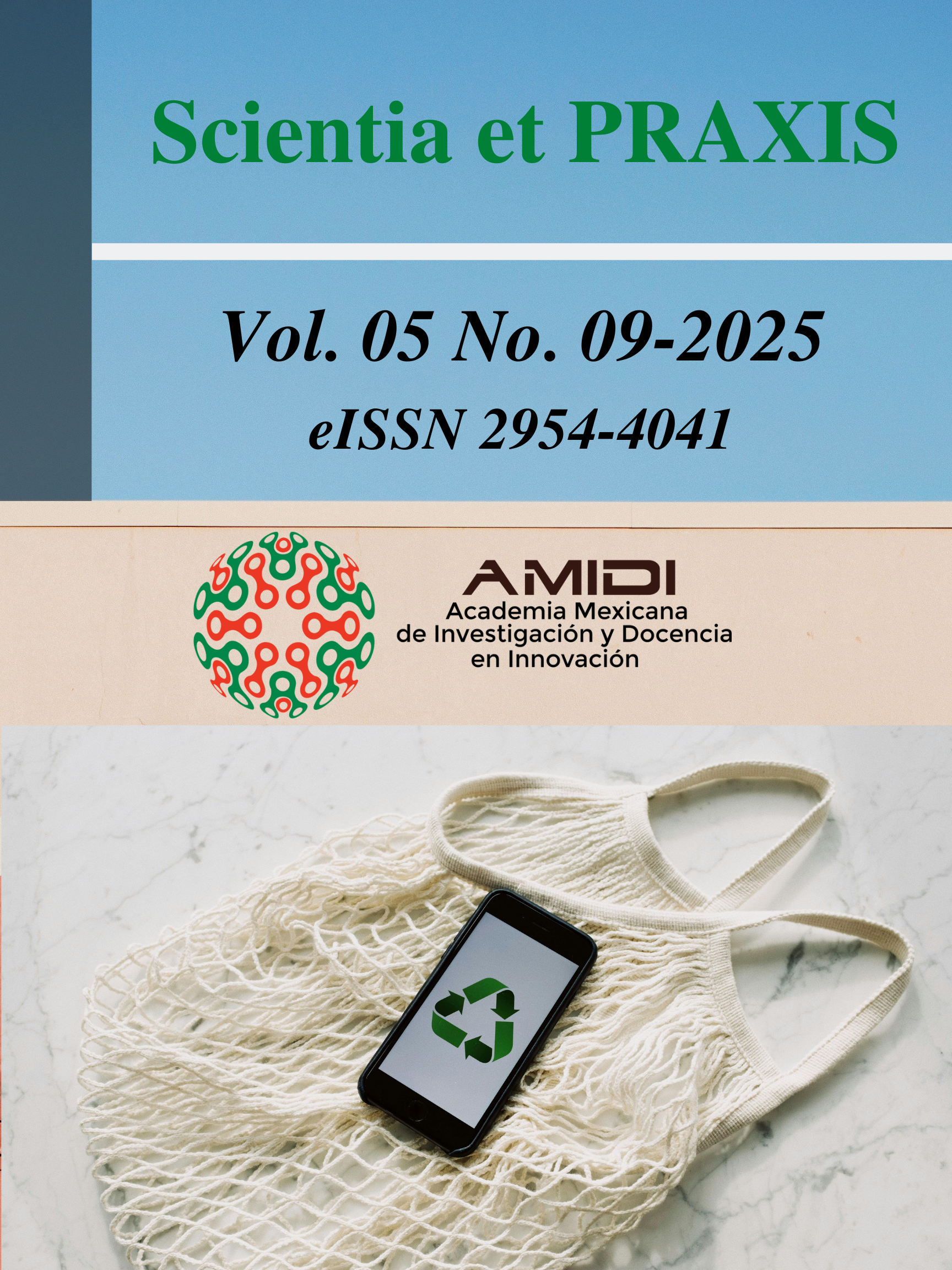Innovación para una Alimentación Saludable: El Etiquetado Frontal Herramienta de Cambio Conductual en Jalisco, México
DOI:
https://doi.org/10.55965/setp.5.09.a2Resumen
Contexto. El aumento en la prevalencia de enfermedades no transmisibles en México, atribuible en parte al consumo de alimentos densamente energéticos, ha motivado la implementación de políticas públicas orientadas a modificar los hábitos alimenticios. Entre ellas, destaca el selllo de advertencia de etiquetado frontal (SAF) como estrategia de bajo costo cognitivo, alineada con los principios del nudge y el ODS3 de la Agenda 2030.
Problema. Existe incertidumbre sobre la efectividad del sello de advertencia frontal (SAF) como mecanismo para reducir el consumo de alimentos poco saludables, en particular en regiones como Jalisco. A ello se suma la escasez de evaluaciones empíricas que contrasten su impacto económico en el comportamiento del consumidor.
Objetivo. Estimar el impacto del etiquetado frontal en el gasto trimestral de hogares urbanos de Jalisco en alimentos densamente energéticos, entre 2016 y 2022.
Metodología. Se utilizó un diseño cuasiexperimental de “diferencias en diferencias” a través del software STATA19 , empleando datos de la Encuesta Nacional de Ingresos y Gastos de los Hogares (ENIGH) 2016, 2020 y 2022. Se compararon hogares urbanos (tratados) y rurales (control) en términos de gasto en doce productos considerados densamente energéticos, según la NOM-051.
Hallazgos teóricos y prácticos. El etiquetado frontal resultó ser eficaz para disminuir el gasto en 10 de los 12 productos evaluados. No obstante, su efecto fue nulo o incluso adverso en bebidas azucaradas y galletas saladas. En términos teóricos, se validó la eficacia del nudge visual como política pública, aunque limitada ante productos de consumo culturalmente arraigado.
Originalidad. El estudio integra enfoques de economía conductual, nutrición pública y políticas públicas, proponiendo una lectura multidisciplinaria sobre la innovación en salud alimentaria. Contribuye al ODS3 al identificar condiciones donde el etiquetado es o no eficaz, sugiriendo ajustes informados a la política vigente.
Conclusiones y limitaciones. El etiquetado es una herramienta valiosa; sin embargo, resulta insuficiente por sí sola. Debe complementarse con medidas fiscales (como impuestos a bebidas azucaradas) y rediseños más accesibles visualmente. El estudio se restringe a Jalisco y al primer periodo del etiquetado SAF, lo cual limita su generalización. Se sugiere extender el análisis a otras entidades federativas y evaluar fases posteriores del etiquetado.
Descargas
Citas
Angrist, J. D., y Pischke, J.-S. (2008). Mostly Harmless Econometrics : An Empiricist ’ s Companion Mostly Harmless Econometrics : An Empiricist ’ s Companion (Princeton University Press (ed.); 1st ed.). Economics Books. https://www.researchgate.net/publication/51992844_Mostly_Harmless_Econometrics_An_Empiricist's_Companion DOI: https://doi.org/10.2307/j.ctvcm4j72
Arellano Gault, D., y Barreto, F. (2016). Gobierno conductual: nudges, cambio de comportamiento inconsciente y opacidad. Foro Internacional, 56(4), 903. https://doi.org/10.24201/fi.v56i4.2384 DOI: https://doi.org/10.24201/fi.v56i226.2384
Ares, G., Antúnez, L., Curutchet, M. R., Galicia, L., Moratorio, X., Giménez, A., y Bove, I. (2021). Immediate effects of the implementation of nutritional warnings in Uruguay: Awareness, self-reported use and increased understanding. Public Health Nutrition, 24(2), 1–12. https://doi.org/10.1017/S1368980020002517 . DOI: https://doi.org/10.1017/S1368980020002517
Briggs, A. D. M., Mytton, O. T., Kehlbacher, A., Tiffin, R., Rayner, M., y Scarborough, P. (2013). Overall and income specific effect on prevalence of overweight and obesity of 20% sugar sweetened drink tax in UK: Econometric and comparative risk assessment modelling study. BMJ, 347. https://doi.org/10.1136/bmj.f6189 DOI: https://doi.org/10.1136/bmj.f6189
Cao, F., Wang, X., y Wang, Z. (2020). Effects of awe on consumer preferences for healthy versus unhealthy food products. Journal of Consumer Behaviour, 19(3), 264–276. https://doi.org/10.1002/cb.1815 DOI: https://doi.org/10.1002/cb.1815
Chiatchoua, C., y Ávila-Romero, R. (2022). Desarrollo Local en la Región de Cunduacán-Tabasco. Scientia et Praxis, 02(04), 104–122. https://doi.org/https://doi.org/10.55965/setp.2.coed.a5 DOI: https://doi.org/10.55965/setp.2.edu.a5
Comisión Federal para la Protección contra Riesgos Sanitarios. (2021). Guía para los Responsables de los productos sujetos a la modificación a la NOM-051-SCFI/SSA1-2010. https://www.gob.mx/cms/uploads/attachment/file/666912/Gu_a_-_Sujetos_regulados_10.0.pdf
Contreras, K., Zuleta, M., Serrano, J., y Veneros, D. (2018). Análisis del comportamiento de compra de estudiantes de educación superior antes alimentos con sellos de advertencia nutricional. Multidisciplinary Business Review, 11(2), 39–47. https://journalmbr.net/index.php/mbr/article/view/277
Dávila-Torres, J., De Jesús González-Izquierdo, J., y Barrera-Cruz, A. (2015). Panorama de la obesidad en México. Revista Medica Del Instituto Mexicano de Seguro Social, 53(2), 240–249. http://revistamedica.imss.gob.mx/editorial/index.php/revista_medica/article/viewFile/21/54
Gorski, M. T., y Roberto, C. A. (2015). Public health policies to encourage healthy eating habits: Recent perspectives. Journal of Healthcare Leadership, 7, 81–90. https://doi.org/10.2147/JHL.S69188 DOI: https://doi.org/10.2147/JHL.S69188
Guimond-Ramos, J. C., Borbón-Morales, C. G., y Mejía-Trejo, J. (2023). Variaciones del gasto de los hogares mexicanos en alimentos de alto contenido energético, 2016-2020. Scientia et PRAXIS, 3(05), 1–25. https://doi.org/10.55965/setp.3.coed1.a1 DOI: https://doi.org/10.55965/setp.3.coed1.a1
Hagmann, D., Siegrist, M., y Hartmann, C. (2018). Taxes, labels, or nudges? Public acceptance of various interventions designed to reduce sugar intake. Food Policy, 79(June), 156–165. https://doi.org/10.1016/j.foodpol.2018.06.008 DOI: https://doi.org/10.1016/j.foodpol.2018.06.008
Hernández-Islas, M. N., Flores-Novelo, A., y Rachó-Barroso, M. del C. (2024). Desarrollo Sostenible a través de la Innovación en Seguridad Alimentaria y Hábitos Alimenticios en Familias Marginadas Sustainable Development Through Innovation in Food Security and Eating Habits in Marginalized Families. Scientia et Praxis, 04(08), 32–60. https://doi.org/https://doi.org/10.55965/setp.4.08.uady.a2 DOI: https://doi.org/10.55965/setp.4.08.uady.a2
Hyseni, L., Atkinson, M., Bromley, H., Orton, L., Lloyd-Williams, F., McGill, R., y Capewell, S. (2017). The effects of policy actions to improve population dietary patterns and prevent diet-related non-communicable diseases: Scoping review. European Journal of Clinical Nutrition, 71(6), 694–711. https://doi.org/10.1038/ejcn.2016.234 DOI: https://doi.org/10.1038/ejcn.2016.234
Instituto Nacional de Estadística y Geografía (2016). Encuesta nacional de ingresos y Gastos de los hogares (ENIGH) 2016. En Enigh 2016.
Instituto Nacional de Estadística y Geografía (2020). Encuesta nacional de ingresos y gastos de los hogares 2020. Diseño conceptual. Inegi, 2020, 133.
Instituto Nacional de Estadística y Geografía (2022). Encuesta Nacional de Ingresos y Gastos de los Hogares 2022 (ENIGH) 26 de julio de 2023 (Vol. 2022). https://en.www.inegi.org.mx/contenidos/programas/enigh/nc/2022/doc/enigh2022_ns_presentacion_resultados.pdf
Instituto Nacional de Estadística y Geografía (2023b). Ingresos y Gastos De Los Hogares (Enigh) 2022 Jalisco (Vol. 2022).
Kahneman, D. (2011). Thinking, Fast and Slow. Farrar, Straus and Giroux.
Kahneman, D., y Tversky, A. (1979). Prospect Theory: An Analysis of Decision under Risk. Econometrica, 47(2), 263–292. https://doi.org/10.2307/1914185 DOI: https://doi.org/10.2307/1914185
Kaufer-Horwitz, M., Tolentino-Mayo, L., Jáuregui, A., Sánchez-Bazán, K., Bourges, H., Martínez, S., Perichart, O., Rojas-Russell, M., Moreno, L., Hunot, C., Nava, E., Ríos-Cortázar, V., Palos-Lucio, G., González, L., González-de Cossio, T., Pérez, M., Borja-Aburto, V. H., González, A., Apolinar, E., … Barquera, S. (2018). Sistema de etiquetado frontal de alimentos y bebidas para México: una estrategia para la toma de decisiones saludables. Salud Pública de México, 60(4, jul-ago), 479. https://doi.org/10.21149/9615 DOI: https://doi.org/10.21149/9615
Lartigue-Mendoza, J., y González-martínez, A. (2022). Los incluidos y los marginados de las telecomunicaciones en México . Un enfoque por hogar The included and the marginalized from telecommunications in Mexico . A household approach Introducción. EconoQuantum, 19(1), 53–82. https://doi.org/: https://doi.org/10.18381/eq.v19i1.7239 DOI: https://doi.org/10.18381/eq.v19i1.7239
Liu, P. J., Wisdom, J., Roberto, C. A., Liu, L. J., & Ubel, P. A. (2014). Using behavioral economics to design more effective food policies to address obesity. Applied Economic Perspectives and Policy, 36(1), 6–24. https://doi.org/10.1093/aepp/ppt027 DOI: https://doi.org/10.1093/aepp/ppt027
Mejía-Trejo, J. (2023). Evaluación de Impacto Social. TOMO I. Uso de STATA con loss métodos: Inferencia Causal, Aleatorización, Propensión de Coincidencia por Puntaje y Doble Diferencia. Academia Mexicana de Investigación y Docencia en Innovación (AMIDI).
https://doi.org/10.55965/abib.2023.9786075956732 DOI: https://doi.org/10.55965/abib.2023.9786075956732
Mendoza-Velázquez, A., y Aguirre Sedeño, D. (2019). Impuesto especial a alimentos y bebidas y su impacto en la inflación en México : dinámica , persistencia y cambio de régimen. Revista Panamericana de Salud Pública, November. https://doi.org/10.26633/RPSP.2019.88 DOI: https://doi.org/10.26633/RPSP.2019.88
ONU (Organización de las Naciones Unidas). (2015). Transformar nuestro mundo: la Agenda 2030 para el Desarrollo Sostenible. https://sdgs.un.org/goals
Secretaría de Economía. (2020). DOF. Diario Oficial de la Federación. https://www.dof.gob.mx/2020/SEECO/NOM_051.pdf
Secretaría de Salud. (2010). NOM-051-SCFI/SSA1-2010, Especificaciones generales de etiquetado para alimentos y bebidas no alcohólicas preenvasados-Información comercial y sanitaria. In Diario Oficial de la Federación. http://dof.gob.mx/nota_detalle.php?codigo=5137518&fecha=05/04/2010
Stern, D., Tolentino, L., y Barquera, S. (2011). Revisión del etiquetado frontal: análisis de las Guías Diarias de Alimentación (GDA) y su comprensión por estudiantes de nutrición en México. In Instituto Nacional de Salud Publica (Vol. 53). https://www.insp.mx/epppo/blog/3225-etiquetado-alimentacion.html
Thaler, R. (1980). Toward a positive theory of consumer choice. Journal of Economic Behavior and Organization, 1(1), 39–60. https://doi.org/10.1016/0167-2681(80)90051-7 DOI: https://doi.org/10.1016/0167-2681(80)90051-7
Thaler, R. H., y Sunstein, C. R. (2009). Un pequeño empujon. Taurus.
Thunström, L. (2019). Welfare effects of nudges: The emotional tax of calorie menu labeling. Judgment and Decision Making, 14(1), 11–25. https://doi.org/10.1017/S1930297500002874 DOI: https://doi.org/10.1017/S1930297500002874
Tolentino-Mayo, L., Sagaceta-Mejía, J., Cruz-Casarrubias, C., Ríos-Cortázar, V., Jauregui, A., y Barquera, S. (2020). Comprensión y uso del etiquetado frontal nutrimental Guías Diarias de Alimentación de alimentos y bebidas industrializados en México. Salud Publica de Mexico, 62(6), 786–797. https://doi.org/10.21149/11568 DOI: https://doi.org/10.21149/11568
Torres, F., y Rojas, A. (2018). Obesidad y salud pública en México : transformación del patrón hegemónico de oferta-demanda de alimentos Obesity and Public Health in Mexico : Transforming the Hegemonic Food Supply and Demand Pattern. Revista Porblemas Del Desarrollo, 193(49), 145–169. https://doi.org/10.22201/iiec.20078951e.2018.193.63185 DOI: https://doi.org/10.22201/iiec.20078951e.2018.193.63185
Vanderlee, L., Franco-Arellano, B., Ahmed, M., Oh, A., Lou, W., y L’Abbé, M. R. (2021). The efficacy of “high in” warning labels, health star and traffic light front-of-package labelling: An online randomised control trial. Public Health Nutrition, 24(1), 62–74. https://doi.org/10.1017/S1368980020003213 DOI: https://doi.org/10.1017/S1368980020003213
Valencia-Valero, R. G., y Ortiz-Hernández, L. (2014). Disponibilidad de alimentos en los hogares mexicanos de acuerdo con el grado de inseguridad alimentaria. Salud Pública de México, 56(2), 154. https://doi.org/10.21149/spm.v56i2.7331 DOI: https://doi.org/10.21149/spm.v56i2.7331
White, M., y Barquera, S. (2020). Mexico Adopts Food Warning Labels, Why Now? Health Systems and Reform, 6(1). https://doi.org/10.1080/23288604.2020.1752063 DOI: https://doi.org/10.1080/23288604.2020.1752063
Publicado
Cómo citar
Número
Sección
Licencia
Derechos de autor 2025 Juan Carlos Guimond-Ramos, León Alejandro Cañez-Cota, Rodrigo Mejía-Mancilla

Esta obra está bajo una licencia internacional Creative Commons Atribución-NoComercial 4.0.











